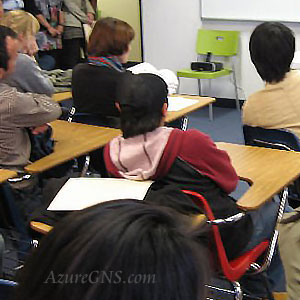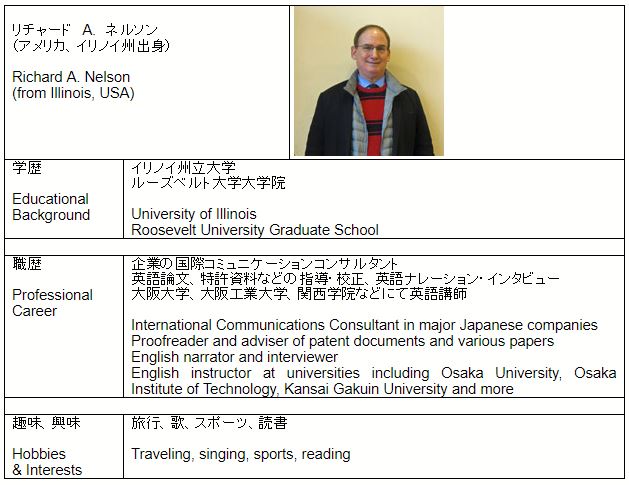これまでの17年とこれから

I recently celebrated my 17th anniversary of living and working in Japan. To say, “my, how time flies” would truly be an understatement. And yet, I have often been asked to summarize my experience of teaching ESL in Japan during the course of my challenging and always surprising years. The best way would be to illustrate two highlights and comment on the significance of those events from a teaching perspective.
To begin with, I would like to mention how challenging it is to get Japanese learners to understand the importance of “decreasing formality” when it comes to being successful communicating with native English speakers. Let me illustrate by sharing the following experience.
A few years after my arrival in Japan, I secured a contract through one of my business English employers to teach basic business ESL skills at a well-known chemical company in Osaka. Upon arriving at the classroom, one of the employees, who I had met the week before at the orientation meeting, walked in and I greeted him. “Good afternoon, Mr. Shimizu. How are you today?” He looked at me and replied, “I am fine. And you?” It was a nice formal and yet personal exchange for our first class together.
Over the course of time, Mr. Shimizu continued to study English with me from one term to the next. As we began our third year together, I started to gradually loosen up and hoped our relationship would do the same. One day, as Mr. Shimizu entered class, I said, “Hi, Takafumi. Do you have any good news today?” He looked at me and replied, “I am fine. And you?” Suddenly, I thought how interesting his response was after three years of continuous, twice-a-week practice.
Nevertheless, Mr. Shimizu continued to enroll in the company-sponsored ESL course. We now fast forward to the fifth year of our class, when one day, Mr. Shimizu entered my class, as usual, before any of the other participants. Surely, after five years in the same class, with the same employees and in the same company environment as well as practicing with the same trainer, you would think that formality would be the least of my worries at this point in time. Right?
Confidently and naturally, I addressed Mr. Shimizu in what I thought would be a relaxed form of greeting after five years, by saying, “Hey, Tak. What is going on today?” And of course, you probably guessed, he looked at me and replied, “I am fine. And you?”
Let it be said loud and clear, that extreme patience is needed to try and establish natural and relaxed relationships in such a formal and ritual-oriented culture. “When in Rome, do as the Romans do.” However, also remember, “Rome was not built in one day, either.”

My next experience took place a few years later, at a prestigious language school also in Osaka. By this time, I thought I had seen it all and was truly a seasoned veteran that could not be surprised by anything I might encounter in an ESL classroom in Japan.
In the language school, I was one of many foreign teachers who was assigned a daily schedule of eight, 50-minute classes, held in portable cubicle-style classrooms, each containing three students per period.
One day, as I entered my designated practice room, I greeted the three somewhat eager but low-level students who were trying to make eye contact with me and took my seat across from a cute but reserved female learner who I had not previously taught.

As I looked at her, I noticed she had body language that seemingly indicated a feeling of being rather cold. This made perfect sense to me because I had also noticed she was sitting directly under the air-conditioning unit that was attached to the ceiling above her seat.
Being the kind and considerate teacher I thought I was, I asked her before starting the class, “Are you OK?” She replied, “I am fine.” That response indicated to me that it was time to begin our, what I hoped to be, exciting class.
As the drills progressed, the other two male individuals in our group, who were about the same age, were much more active and responsive than the female learner. On top of that, her seemingly cold-natured body language remained unchained. Trying to do what I could to promote an equal-opportunity learning environment, I once again asked her, “Are you OK? You are rather quiet.” Seemingly on cue, she looked at me and stated, “I am fine.” By the way, if you are keeping count, that was strike two for me!
As the ending time of our class approached, I did my summary and wrap-up to get ready to finish our session for the day. And before I dismissed the group, one more time, I asked the female participant who looked like she was about to be frozen solid, “Are you sure you are OK?” Lo and behold, never changing her expression, she looked at me and stated once more for the record, “I am fine.” Yes, that was strike three for me!
Even so, I could not resist, so I stated, “You sure were quiet today. I think you are very cold, yes?” She responded, as if to help me understand what I seemingly did not, “I am fine.” I thereby said goodbye to everyone and left the cubicle for the break room to write my comments regarding the performance of each student.
As I was about to finish writing my observations and return the files to the shelf, I was summoned to the office to see the school manager. When I got there, the manager was standing next to the female student and they were both looking at me with extremely disapproving looks on their faces.
“What is the problem?” I asked innocently. The manager scowled at me and asked, “Why did you tell this student she had a cold personality?” “What?” I shrieked. “I simply said that this student looked like she was feeling cold because she had been sitting under the air-conditioning unit the entire class. I was worried because she seemed so uncomfortable and could not actively participate in our class activities.”
As I finished defending myself, I noticed that the female student had become very red-faced and began to profusely apologize over and over again before quickly leaving the office. She had obviously confused the meaning of “cold feeling” with “cold personality.”
After my manager did her share of appropriately apologizing to me, it dawned on me that one can never take for granted the words and mannerisms of communication. What is commonly known and understood by one individual can be totally misunderstood by another. From that moment on, I vowed to be on my toes and take more care with my words and expressions with future Japanese learners.
Needless to say, my cultural and professional experiences are constantly changing on a daily basis even after 17 years on the job. Whoever said that teaching ESL in Japan would be easy? Someday you might be able to read more about my escapades in Japan in a book I am thinking about writing.


